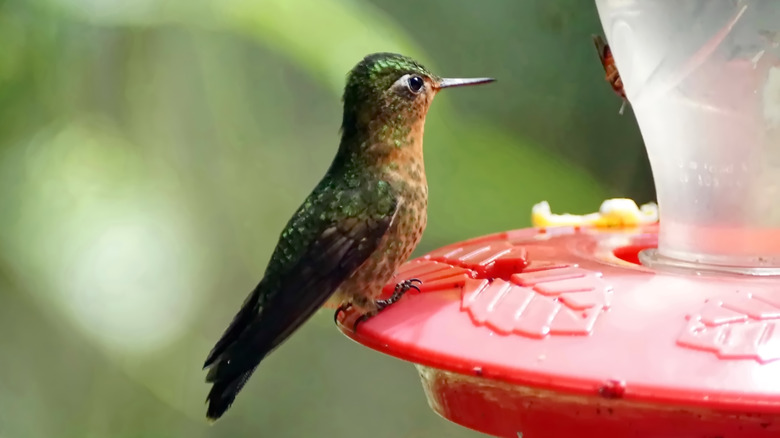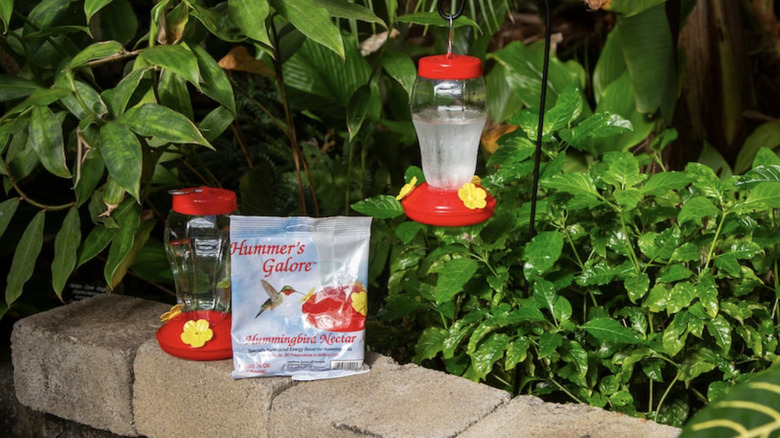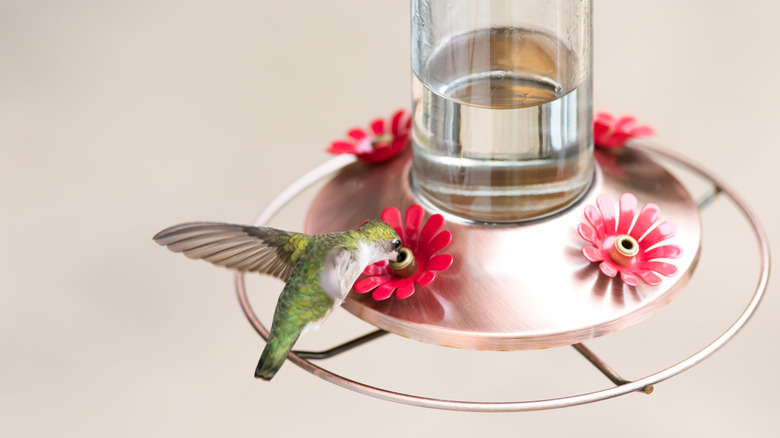Is Dollar Tree's Hummingbird Nectar Good For Birds? Here's What You Need To Know
Dollar Tree is a great spot to hunt for garden essentials on a budget, but can the same be said for its hummingbird-friendly products? Hummer's Galore Hummingbird Nectar, sold on Dollar Tree's website and in select stores for $1.25 per 4-oz package, is a convenient alternative to homemade nectar. It contains simple ingredients that serve as a source of energy for hummingbirds. These fascinating birds must refuel with nectar and bugs every 15 minutes, as they are constantly in motion and rapidly burning calories. Despite their tiny size, hummingbirds can fly as fast as 33 miles per hour and beat their wings up to 5,400 times per minute. Needless to say, having a hummingbird feeder full of nectar, particularly in areas where they tend to migrate, is very beneficial. However, certain ingredients found in store-bought nectar can do more harm than good. Although Hummer's Galore Hummingbird Nectar contains naturally derived ingredients and isn't the most harmful option on the shelf, it may not be the most nourishing choice for hummingbirds either.
Hummingbirds have incredibly fast metabolisms — 77 times faster than that of humans. Their metabolisms are also very sophisticated, with the ability to convert various types of sugar into energy. However, it turns out that these energetic vertebrates benefit most from only one type of sugar, and it's likely one that you already have in your pantry. Homemade hummingbird nectar is surprisingly easy to make at home, and it's truly the best way to give them exactly what they need.
Hummer's Galore may not be a hummer's delight
Hummer's Galore Hummingbird Nectar is said to contain natural ingredients without any dyes or artificial sweeteners. Each packet contains a ready-made formula of sucrose and dextrose — the only preparation required is dissolving it in water. Sucrose, commonly known as sugar, is safe and easy for hummingbirds to digest. Dextrose, on the other hand, is simple sugar. Though it is a natural sugar derived from plants like wheat and corn, it is not the ideal form of nourishment for hummingbirds. These birds cannot convert other forms of sugar, such as dextrose, into energy as efficiently as sucrose. Additionally, hummingbirds prefer sucrose to other types of sugar, as it most closely resembles the type of sugar found in flower nectar.
Dextrose is a simple sugar that ferments more quickly than sucrose and is often used as an ingredient to speed up the fermentation process to produce yeast. A hummingbird feeder left to sit out in the sun for too long becomes the perfect vessel for fermentation, particularly if it contains dextrose, as fermentation converts sugar into ethanol. Hummingbirds can tolerate a small amount of yeast and ethanol, as it is a byproduct of the part of the sugar fermentation process found in nature. However, yeast is a bacteria that may affect the nutritional value of the nectar, as ethanol can become toxic to hummingbirds if consumed in large amounts.
Make nutritious hummingbird nectar at home
Why go through the trouble of purchasing store-bought nectar when you can make your very own solution at home? You'll save money, and your homemade version is actually safer for hummingbirds than what you'd find in stores. All you need is pure white granulated sugar, which experts say is the only sugar you should be using in your DIY hummingbird nectar, as it is free from any traces of ingredients that may be toxic to hummingbirds. Other sweeteners like brown sugar and honey should be avoided for their potentially harmful effects. Do not add any other ingredients to attract hummingbirds to your feeder, such as red dye, as it could make the nectar more difficult to digest. Add one-quarter cup of white sugar to a cup of boiling water, mix in a bowl, and wait for the liquid to cool down before pouring it into your feeder. Ensure that the feeder is clean and placed in an area that is safe and easy for the birds to access, away from wind and potential predators like hawks or the neighborhood cat.
Ongoing maintenance is equally as important for the health and safety of the hummingbird visitors in your yard. One of the most harmful DIY hummingbird nectar mistakes you can make is neglecting to clean the feeder regularly and refilling it with fresh nectar. Particularly during the summer, the feeder should be cleaned and replenished every couple of days to prevent mold and bacteria from contaminating the nectar. No need to bother with ready-made mixtures like Hummer's Galore Hummingbird Nectar — a single bag of pure white sugar is all you need to provide these active vertebrates with an optimal source of fuel.


